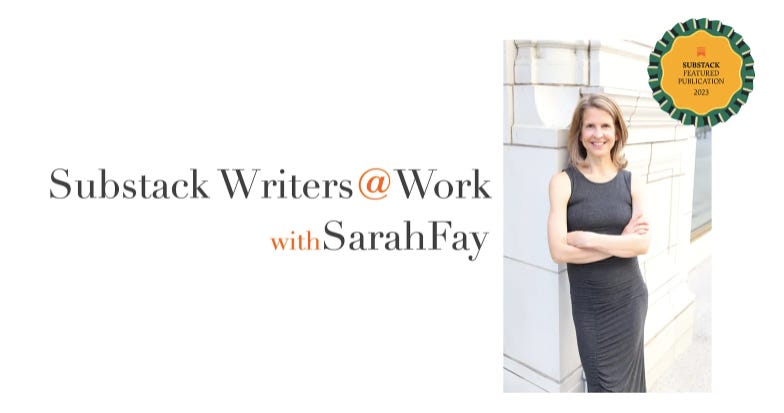DO THIS if you want to become a better writer. (And avoid the mistakes I made)
Seriously - these are top tips from a Substack bestseller
When I began publishing my first Substack serial, I had no idea what I was doing. Literally no idea.
You can read the full archive of Bertha’s Tale HERE. It’s a historical fiction novel set in sixth-century England that gives a voice to a quietly influential woman who changed the course of history for these little islands. I’m so proud of it, but I’ll be honest and say it’s not very good. Not when I first set out, anyway.
I had recently joined the platform to pursue my love of history while on maternity leave. (3 months post baby I needed something to rescue my brain from the pile of spaghetti it had turned into…)
I thought that publishing chapter by chapter would instantly draw a mountain of readers who would be so hooked on my incredibly industry-changing story that I would quickly slide onto the shelves of well-known bookstores as a traditionally-published author.
Looking back I admire my aspiration.
I had not taken the time, however, to learn anything about the craft of writing serials. I’d just started writing…
So when I set about planning for my second serial novel, I knew I had to do things differently. I’ll be more honest than I was in yesterday’s post, "Cliffhangers get exhausting": The inside scoop on keeping readers engaged: this series on serialisation grew from a Note I posted asking for advice on serialisation.
I wanted Hild’s Tale to be better. To find its readers. To become an essential part of my subscribers’ lives. (Yes, they’re big goals - but if you aim for the moon at least you’ll land amongst the stars!)
I knew EXACTLY who I needed to ask about the nuts and bolts of serialisation.
is a Substack bestseller and featured writer, with over 22,000 subscribers. She has written extensively about using Substack for serialisation and has very kindly given permission to share her advice here. This article, by nature of its length, will only touch the surface of the experience she shares with her members on , so I would highly recommend joining her membership if you are serious about serialisation. Thank you Sarah for allowing me to share your advice here today!In this post, we’ll cover…
Why should I serialise my novel?
Why should I use Substack to host my serial?
3 key questions Sarah Fay advises all writers to consider first
How can we keep readers engaged as the serial progresses?
Why should I serialise my novel?
Writing serially helps us to become better writers and write more mature books.
In her audio post, Yes, You Should Serialize Your Memoir on Substack, Sarah explains that the process of editing down to a relatively small word count forces you to ‘get rid of excess and really think about what you want to say and how you’re going to say it’.
Sarah also believes that serialising also makes you ‘write for the reader rather than yourself’. Writing (or at least publishing) chunk by chunk provides a feedback loop for writers that they just wouldn’t get when publishing all in one go. We can monitor engagement and make changes as we go, learning what it is that readers want from our writing.
Let’s serialise … not just to get subscribers but to produce the best books we can and to become the best writers that we can.
Sarah Fay
Why should I use Substack to host my serial?
The following is a summary of what Sarah says in her audio post, Yes, You Should Serialize Your Memoir on Substack.1
Substack has the standalone factor. We can get readers really excited for each instalment through our interactions with them in the post itself as well as on email, Notes, and chat (more on this below).
Substack has the right perspective. Substack is, primarily, an email platform: although many writers use Notes, most subscribers read our posts in email. They are used to reading information directed to them in email, especially if it is written in the first person (this is why Sarah thinks Substack is particularly effective for memoir).
Substack has the potential to build a platform for editors. Check out the quote below to see how Sarah was encouraged by her editor to serialise on Substack.
It’s an opportunity to show proof of concept to agents and editors (i.e., that people are interested and will buy the book). Right now, publishers don’t consider writing on Substack previously published. My editor at HarperCollins encouraged me to serialize my new memoir Cured (the sequel to my journalistic memoir Pathological: The True Story of Six Misdiagnoses) before we go to sell it. My powerhouse agent and I ultimately made the decision to do so together—I mention that she’s a powerhouse to reassure you she knows her stuff.
3 key questions Sarah Fay advises all writers to consider first
As detailed in her post Decisions to Make Before (or as) You Serialize Your Novel or Memoir, Sarah says it is important to think in advance about what we want to write, why we want to write it, and how we will know it’s successful. Our answers to these questions will dictate the form our serial will take, so clarity in the planning stage will lead to a more coherent narrative.
What do you want to produce?
A narrative that will exist only as a serial?
A work that may end up as a book?
Why are you doing this? What do you want to achieve?
Attract subscribers to your newsletter?
Draw readers to this particular novel/memoir?
Have a sandbox to see what resonates with readers?
How will you measure success?
Attract thirty free subscribers during the serialization?
Post every week without fail?
How can we keep readers engaged as the serial progresses?
This was, perhaps, the most asked question in a crowdsourcing Note I put out a few weeks ago. Here’s Sarah’s top tips (drawn from her article, 6 Elements a Successful Serial Novel Needs):
Give each instalment a suggestive title. ‘Chapter 1’ simply won’t do for a serial, and might even put readers off if they think they’ve missed too much to join in.
Maintain punctuality. Have you promised a new instalment every week? Make sure you deliver. Fancy letting it run on longer than readers signed up for? Don’t.
Think in terms of the serial community’s needs. We addressed this one earlier - write for the reader, not for yourself. Substack is, after all, a community of creatives, and your serial will see a larger audience if your readership is regularly liking, commenting, and restacking.
Add suspense between instalments. The reader needs to be thinking “gaaahhhh why did they stop there??!!”
gave a great explanation of how to do this without using a barn-door-obvious cliffhanger in yesterday’s post (How to create a story that gets the reader invested in “what happens next?”).Understand the importance of pacing. There’s little time to ‘warm up’ or ‘set the scene’ in a serial. We still need those lower emotional intensity scenes, but they must be crafted carefully enough (with an action point) to sustain the forward momentum of the story.
Have a weekly point of view. Dickens was a master of this, including the who, what, where, when and (some of the) how in the opening paragraph. Sarah gives a worked example in her post The Secret to Writing a Great Serialized Novel or Memoir.
Are you or a friend currently writing a serial or thinking of writing one?
Make sure to save this article so that you have it to hand when you come to edit those instalments and hit publish, and share it with others you know would find value in it.
What are your experiences with writing or reading serial fiction?
I know that I will be working particularly hard on instalment length and punctuality during the year-long run of my current medieval historical fiction serial, Hild’s Tale. I let the instalments on my previous serial vary between 700 and 3000 words which, in addition to being both too short and too long, did not provide the consistency readers like to expect. I learnt a lot during that first serial, and have definitely gone into the second with my eyes a lot more open.
It’s worth noting at this stage that Sarah writes memoir and believes that Substack works especially well for serialised memoirs. She does, however, explore in this post (and others in her serialisation series) how novels can be adapted to succeed on the platform too.








Interesting that the assumption here is that the serialization is of an otherwise unpublished novel. In my case I am serializing a novel that came out just at a point in my life when family issues needed all my attention, and so got little promotion. I thought I'd see if exposing readers to it in small stages encourages them to be 'impatient' and buy it. I don't know yet if the idea works, because the buy link is to a indie site that reports quarterly. But I lose nothing by doing it & perhaps pick up a few readers for all my books through it. An experiment.
I'm still debating whether to serialize the work in progress when I feel it's reached an appropriate point, because I will not change my style to 'fit' what may best for serialization.
I'm serializing my crime novel here on Substack. I'm primarily doing this for a final edit before I query, but I would live to get readers engaged and providing feedback. No luck on that yet, but I'm publishing a chapter a day so, crossing my fingers.